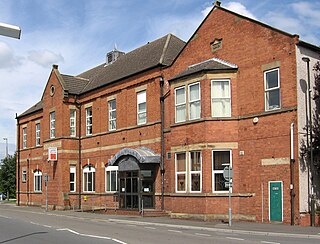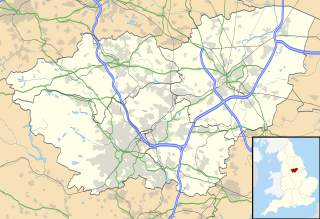
Staveley is a former mining town in the borough of Chesterfield, Derbyshire, England, alongside the River Rother, between Eckington to the north, Barlborough to the east, Sutton cum Duckmanton to the south and Brimington to the west.

Kiveton Park, informally Kiveton, is a village within the Metropolitan Borough of Rotherham, in South Yorkshire, England. Historically a part of the West Riding of Yorkshire, from the Norman conquest to 1868, Kiveton was a hamlet of the parish of Harthill-with-Woodall. It subsequently transferred to the civil parish of Wales which takes its name from the neighbouring village.

Hackenthorpe is a village 5 miles south east of Sheffield’s city centre, now classed as a historic township of the city. Due to much expansion, the village became a part of Sheffield city during the 1950s. During much of the late 19th and 20th centuries the village was noted for its steelmaking, with the Thomas Staniforth & Co Sickle works being based at Main Street. Another prominent feature of the village is the 17th century Hackenthorpe Hall, built by John Newbould for the Hounsfield family, with James Hounsfield being a prominent land owner. The building is today used as a nursery.

Killamarsh is a town and civil parish in North East Derbyshire, England, bordering Sheffield and South Yorkshire to the North West. Killamarsh is surrounded by, in a clockwise direction from the north, Rother Valley Country Park, Wales, Kiveton, Woodall, Harthill, Barlborough, Spinkhill, Renishaw, Eckington, and the Sheffield suburbs of Oxclose, Halfway and Holbrook.
The South Yorkshire Railway was a railway company with lines in the south of the West Riding of Yorkshire, England.

Orgreave Colliery was a coal mine situated adjacent to the main line of the Manchester, Sheffield and Lincolnshire Railway about 5 miles (8 km) east of Sheffield and 3.5 miles (6 km) south west of Rotherham. The colliery is within the parish of Orgreave, from which it takes its name.

The Birley Collieries were a group of coal mines set in the Shire Brook Valley in south east Sheffield, South Yorkshire, England. They were connected to the railway system by a branch line from the Manchester, Sheffield and Lincolnshire Railway at Woodhouse East Junction, about 800 yards east of Woodhouse station.
The Sheffield Coal Company was a colliery owning and coal selling company with its head office situated in South Street, Sheffield, South Yorkshire, England.
Treeton Colliery was a coal mine situated in the village of Treeton, near Rotherham, South Yorkshire, England.
Tinsley Park Collieries were a group of coal mines situated in the Tinsley / Darnall area to the east of the City of Sheffield, South Yorkshire, England.
Kilnhurst Colliery, formerly known as either Thrybergh or Thrybergh Hall Colliery, was situated on the southern side of the village of Kilnhurst, near Rotherham, South Yorkshire, England.

Kiveton Park Colliery was a coal mine in the village of Kiveton Park, near Rotherham, South Yorkshire, England.
Waleswood Colliery was a coal mine situated between Swallownest and Wales Bar, near Rotherham, South Yorkshire, England. The colliery was adjacent to the Rotherham to Clowne road and the main line of the Manchester, Sheffield and Lincolnshire Railway about 2 miles east of Woodhouse.
Warren Vale Colliery was a coal mine, also known as Piccadilly Colliery, situated alongside Warren Vale Road, between Rawmarsh and Swinton, South Yorkshire, England, in the valley of the Collier Brook, which runs east, for about two miles towards Kilnhurst.
The South Yorkshire Coalfield is so named from its position within Yorkshire. It covers most of South Yorkshire, West Yorkshire and a small part of North Yorkshire. The exposed coalfield outcrops in the Pennine foothills and dips under Permian rocks in the east. Its most famous coal seam is the Barnsley Bed. Coal has been mined from shallow seams and outcrops since medieval times and possibly earlier.

Roundwood Colliery was a coal mine situated in the Don Valley, about 2 miles north of Rotherham, South Yorkshire, England on the borders of Rotherham and Rawmarsh.

To develop coal seams in the area, the Sheffield Coal Company opened a new colliery between Swallownest and Beighton, at that time on the borders of Rotherham Rural District and Derbyshire but now just within the borough of Rotherham. The company, which became part of the United Steel Companies in 1937, already owned other collieries in the area, particularly the Birley Collieries and that at Aston Common, known as North Staveley Colliery.
Whittington railway station is a former railway station on the southern edge of New Whittington, Derbyshire, England.
Markham & Co. was an ironworks and steelworks company near Chesterfield, Derbyshire, England.
Beighton Junction is a set of railway junctions near Beighton on the border between Derbyshire and South Yorkshire, England.








